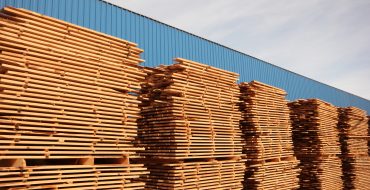
Since the beginning of the pandemic, lumber prices have been more volatile than at almost any other time in history, leading to some major headaches for homebuilders and buyers.
In fact, the volatile swings in lumber over the past year alone have pushed the average price of a new single-family home up more than $18,600, according to the National Association of Homebuilders.
Over the past three months, however, with interest rates rising and the housing market cooling, demand for lumber is falling—and so are prices.
Lumber futures are down over 50% since this year’s January peak of $1,329 per thousand board feet to $651 on Wednesday.
But before we jump into where lumber prices are headed, it’s important to look back over the past two years to see how the market got to where it is today.
The two lumber bubbles of the pandemic era
There have been two major spikes in lumber prices since 2020. The first began when COVID-19 lockdowns caused the market’s suppliers to anticipate a slowdown in demand, leading sawmills to furlough staff and reduce production.
By April 2020, U.S. wood production had fallen 15% from 2019’s levels.
The move by mills was a logical one at the time, but record fiscal and monetary stimulus, a home renovation boom, and historically low mortgage rates ended up spurring demand for homebuilding and, consequently, for lumber.
Falling supply and rising demand led lumber prices to soar over 300% from pre-pandemic levels through May 2021.
“From 2020 to the first half of 2021, it really was an issue of production at the mill,” Dustin Jalbert, a senior economist who leads Fastmarkets RISI’s lumber team, told Fortune. “There just wasn’t enough sawmill output, not enough wood products output, to meet demand.”
Of course, the historic rise wasn’t sustainable. Record lumber prices crushed builders’ and remodelers’ budgets, and eventually, the lumber bubble popped as buyers began to balk and seek alternatives.
“The culprit [of the correction] was the demand side,” Stinson Dean, CEO of Deacon Lumber, told Fortune’s Lance Lambert in September 2021. Homebuilders saw the “full brunt” of rising lumber prices “and completely hit the brakes.”

Lumber price relief proved to be short-lived, however. Supply-chain woes, exacerbated by high labor costs and flooding in lumber-producing British Columbia, kicked off a second wave of price increases through March of this year.
“I would say that this latest run…has been largely a crisis of shipping and logistics,” Jalbert said, “You had this kind of one-two-three punch of flooding in B.C. [British Columbia], a COVID wave, and then on top of that, we hit a seasonally slow period for shipping anyway.”
Add to that a bad wildfire season in the Pacific Northwest—a key production center for North American softwood—and a shortage of around 4 million U.S. homes relative to demand that led homebuilders to continue building, and the results weren’t pretty. Lumber futures soared back above $1,000 per thousand board feet by the start of 2022.
But since then, prices have once again plummeted more than 50%, and more downside could lay ahead.
Where does lumber go from here?
With mortgage rates soaring and the home renovation boom fading, Jalbert told Fortune that lumber’s extreme boom and bust cycles are likely over—barring another unforeseen war or economic crisis.
“I think the worst [of the volatility] is behind us now; that’s the biggest thing,” Jalbert said, adding that there’s a lot of “concern” about what lumber demand will look like in the second half of the year as recession predictions spread.
And he’s not the only one predicting an end to lumber’s wild ride.
“It is our belief that we are past peak demand, and this commodity bull wave is over,” Kyle Little, the chief operating officer at Sherwood Lumber, told Fortune via email. “It is now moving to its next cycle.”
Little posed the question: “What does the price of lumber or even housing do in an environment where demand is flat to down and supply is slowly rising?”
The obvious answer? Prices decline.
“It all comes back to basic Econ 101—supply and demand,” Jalbert explained. “When it comes down to it, it’s just sometimes in the short term, it [the supply-demand balance] doesn’t correct, because the supply side just takes a lot of time to respond.”
While logistical problems in the industry remain, and a backlog of demand from industry buyers who balked at previous record prices is keeping cash prices—as opposed to futures prices—relatively high, Little said that producers are “hyper-focused” on getting through their current commitments, which should lead to lower futures prices from here.
“Many are struggling to determine the next steps with current inflation woes, interest rate increases, and equity unraveling. This lack of clarity on future demand is putting significant pressure on the commodity price down the road,” he said.
Prices will likely moderate from here to between $450 and $600, but they won’t collapse, Jalbert argues.
There’s a “historic” spread between housing starts and completions that should keep homebuilders busy over the next year, stabilizing demand, he said.
“We have a hard time seeing, you know, this sort of being like a housing bubble,” Jalbert added. “There’s still decent underlying demand that will support housing construction.”